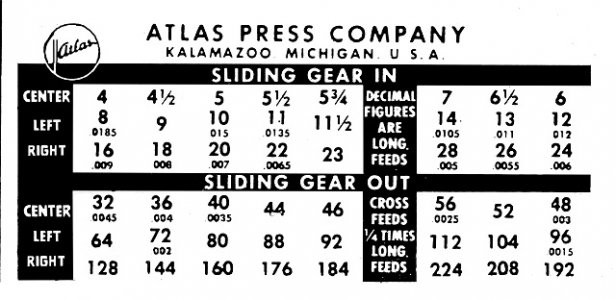- Joined
- May 7, 2015
- Messages
- 269
I have been looking at a lot of charts of the proper lathe speeds and feeds.
It appears that many of the charts show feeds for different material cutter material, either HSS or carbide.
The charts show feed per revolution, usually either in metric or fractions of an inch per revolution.
My lathe is a Clausing 6316 and has a feed chart, but it does not have a unit of measure, I am assuming it is based on SFM (surface feet per minute).
See included chart.
My question is is there a way to convert the recommended FPR to SFM or IPM (inches per minute)
I see some feeds in thousands of an inch, but what about the other feeds not given in thousands of an inch.
So when I turn a given material I can use the appropriate feed rates?
Thanks
Joe

It appears that many of the charts show feeds for different material cutter material, either HSS or carbide.
The charts show feed per revolution, usually either in metric or fractions of an inch per revolution.
My lathe is a Clausing 6316 and has a feed chart, but it does not have a unit of measure, I am assuming it is based on SFM (surface feet per minute).
See included chart.
My question is is there a way to convert the recommended FPR to SFM or IPM (inches per minute)
I see some feeds in thousands of an inch, but what about the other feeds not given in thousands of an inch.
So when I turn a given material I can use the appropriate feed rates?
Thanks
Joe


